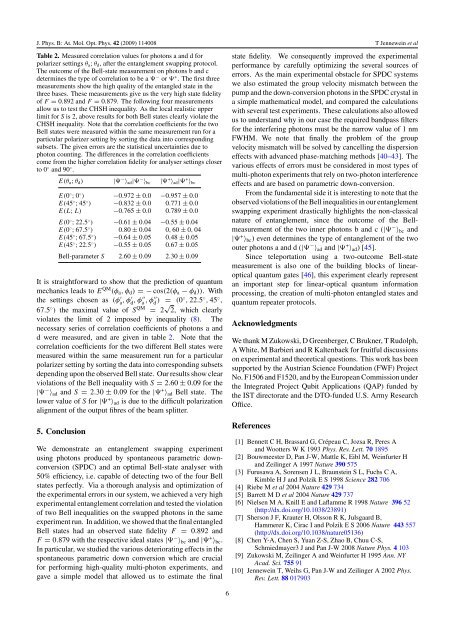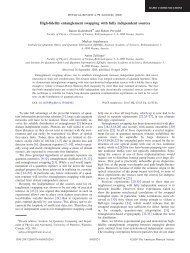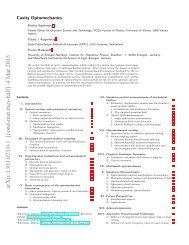Performing high-quality multi-photon experiments with parametric ...
Performing high-quality multi-photon experiments with parametric ...
Performing high-quality multi-photon experiments with parametric ...
Create successful ePaper yourself
Turn your PDF publications into a flip-book with our unique Google optimized e-Paper software.
J. Phys. B: At. Mol. Opt. Phys. 42 (2009) 114008 T Jennewein et alTable 2. Measured correlation values for <strong>photon</strong>s a and d forpolarizer settings θ a ; θ d , after the entanglement swapping protocol.The outcome of the Bell-state measurement on <strong>photon</strong>s b and cdetermines the type of correlation to be a − or + . The first threemeasurements show the <strong>high</strong> <strong>quality</strong> of the entangled state in thethree bases. These measurements give us the very <strong>high</strong> state fidelityof F = 0.892 and F = 0.879. The following four measurementsallow us to test the CHSH ine<strong>quality</strong>. As the local realistic upperlimit for S is 2, above results for both Bell states clearly violate theCHSH ine<strong>quality</strong>. Note that the correlation coefficients for the twoBell states were measured <strong>with</strong>in the same measurement run for aparticular polarizer setting by sorting the data into correspondingsubsets. The given errors are the statistical uncertainties due to<strong>photon</strong> counting. The differences in the correlation coefficientscome from the <strong>high</strong>er correlation fidelity for analyser settings closerto 0 ◦ and 90 ◦ .E(θ a ; θ d ) | − 〉 ad | − 〉 bc | + 〉 ad | + 〉 bcE(0 ◦ ; 0 ◦ ) −0.972 ± 0.0 −0.957 ± 0.0E(45 ◦ ; 45 ◦ ) −0.832 ± 0.0 0.771 ± 0.0E(L; L) −0.765 ± 0.0 0.789 ± 0.0E(0 ◦ ; 22.5 ◦ ) −0.61 ± 0.04 −0.55 ± 0.04E(0 ◦ ; 67.5 ◦ ) 0.80 ± 0.04 0, 60 ± 0, 04E(45 ◦ ; 67.5 ◦ ) −0.64 ± 0.05 0.48 ± 0.05E(45 ◦ ; 22.5 ◦ ) −0.55 ± 0.05 0.67 ± 0.05Bell-parameter S 2.60 ± 0.09 2.30 ± 0.09It is straightforward to show that the prediction of quantummechanics leads to E QM (φ a ,φ d ) =−cos(2(φ a − φ d )). Withthe settings chosen as (φ a ′,φ′ d ,φ′′ a ,φ′′ d ) = (0◦ , 22.5 ◦ , 45 ◦ ,67.5 ◦ ) the maximal value of S QM = 2 √ 2, which clearlyviolates the limit of 2 imposed by ine<strong>quality</strong> (8). Thenecessary series of correlation coefficients of <strong>photon</strong>s a andd were measured, and are given in table 2. Note that thecorrelation coefficients for the two different Bell states weremeasured <strong>with</strong>in the same measurement run for a particularpolarizer setting by sorting the data into corresponding subsetsdepending upon the observed Bell state. Our results show clearviolations of the Bell ine<strong>quality</strong> <strong>with</strong> S = 2.60 ± 0.09 for the| − 〉 ad and S = 2.30 ± 0.09 for the | + 〉 ad Bell state. Thelower value of S for | + 〉 ad is due to the difficult polarizationalignment of the output fibres of the beam splitter.5. ConclusionWe demonstrate an entanglement swapping experimentusing <strong>photon</strong>s produced by spontaneous <strong>parametric</strong> downconversion(SPDC) and an optimal Bell-state analyser <strong>with</strong>50% efficiency, i.e. capable of detecting two of the four Bellstates perfectly. Via a thorough analysis and optimization ofthe experimental errors in our system, we achieved a very <strong>high</strong>experimental entanglement correlation and tested the violationof two Bell inequalities on the swapped <strong>photon</strong>s in the sameexperiment run. In addition, we showed that the final entangledBell states had an observed state fidelity F = 0.892 andF = 0.879 <strong>with</strong> the respective ideal states | − 〉 bc and | + 〉 bc .In particular, we studied the various deteriorating effects in thespontaneous <strong>parametric</strong> down conversion which are crucialfor performing <strong>high</strong>-<strong>quality</strong> <strong>multi</strong>-<strong>photon</strong> <strong>experiments</strong>, andgave a simple model that allowed us to estimate the finalstate fidelity. We consequently improved the experimentalperformance by carefully optimizing the several sources oferrors. As the main experimental obstacle for SPDC systemswe also estimated the group velocity mismatch between thepump and the down-conversion <strong>photon</strong>s in the SPDC crystal ina simple mathematical model, and compared the calculations<strong>with</strong> several test <strong>experiments</strong>. These calculations also allowedus to understand why in our case the required bandpass filtersfor the interfering <strong>photon</strong>s must be the narrow value of 1 nmFWHM. We note that finally the problem of the groupvelocity mismatch will be solved by cancelling the dispersioneffects <strong>with</strong> advanced phase-matching methods [40–43]. Thevarious effects of errors must be considered in most types of<strong>multi</strong>-<strong>photon</strong> <strong>experiments</strong> that rely on two-<strong>photon</strong> interferenceeffects and are based on <strong>parametric</strong> down-conversion.From the fundamental side it is interesting to note that theobserved violations of the Bell inequalities in our entanglementswapping experiment drastically <strong>high</strong>lights the non-classicalnature of entanglement, since the outcome of the Bellmeasurementof the two inner <strong>photon</strong>s b and c (| − 〉 bc and| + 〉 bc ) even determines the type of entanglement of the twoouter <strong>photon</strong>s a and d (| − 〉 ad and | + 〉 ad )[45].Since teleportation using a two-outcome Bell-statemeasurement is also one of the building blocks of linearopticalquantum gates [46], this experiment clearly representan important step for linear-optical quantum informationprocessing, the creation of <strong>multi</strong>-<strong>photon</strong> entangled states andquantum repeater protocols.AcknowledgmentsWe thank M Zukowski, D Greenberger, C Brukner, T Rudolph,A White, M Barbieri and R Kaltenbaek for fruitful discussionson experimental and theoretical questions. This work has beensupported by the Austrian Science Foundation (FWF) ProjectNo. F1506 and F1520, and by the European Commission underthe Integrated Project Qubit Applications (QAP) funded bythe IST directorate and the DTO-funded U.S. Army ResearchOffice.References[1] Bennett C H, Brassard G, Crépeau C, Jozsa R, Peres Aand Wootters W K 1993 Phys. Rev. Lett. 70 1895[2] Bouwmeester D, Pan J-W, Mattle K, Eibl M, Weinfurter Hand Zeilinger A 1997 Nature 390 575[3] Furusawa A, Sorensen J L, Braunstein S L, Fuchs C A,Kimble H J and Polzik E S 1998 Science 282 706[4] Riebe M et al 2004 Nature 429 734[5] Barrett M D et al 2004 Nature 429 737[6] Nielsen M A, Knill E and Laflamme R 1998 Nature 396 52(http://dx.doi.org/10.1038/23891)[7] Sherson J F, Krauter H, Olsson R K, Julsgaard B,Hammerer K, Cirac I and Polzik E S 2006 Nature 443 557(http://dx.doi.org/10.1038/nature05136)[8] Chen Y-A, Chen S, Yuan Z-S, Zhao B, Chuu C-S,Schmiedmayer3 J and Pan J-W 2008 Nature Phys. 4 103[9] Zukowski M, Zeilinger A and Weinfurter H 1995 Ann. NYAcad. Sci. 755 91[10] Jennewein T, Weihs G, Pan J-W and Zeilinger A 2002 Phys.Rev. Lett. 88 0179036




